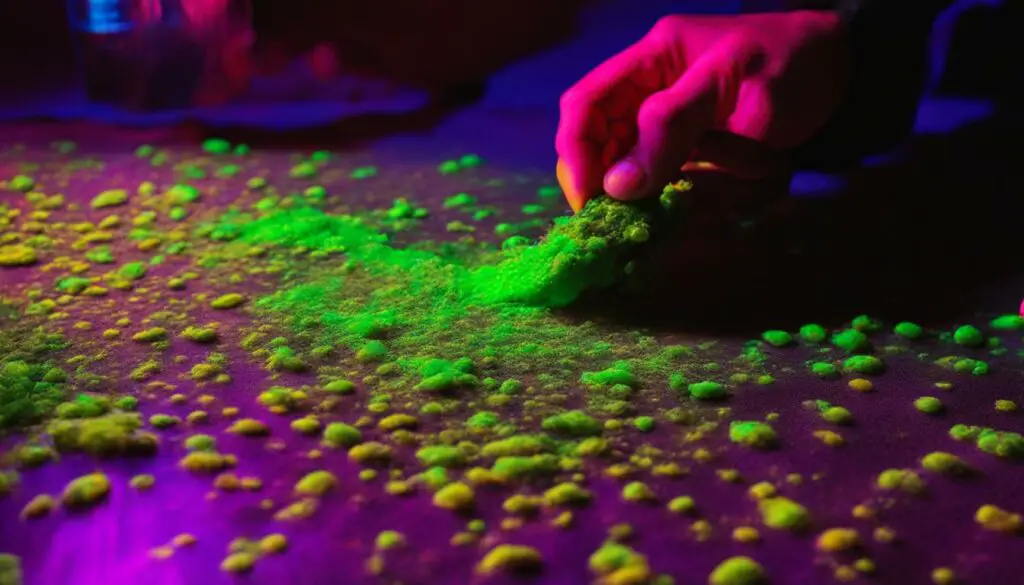If your cat has developed the habit of peeing wherever it wants, you might have a huge and recurring problem. It can be difficult to find the source of cat urine odor, especially if the urine has dried and the obvious signs have disappeared. In this guide, I will show you effective techniques and methods to locate and identify cat urine stains on your carpet, so you can easily eliminate the odor and keep your home smelling fresh.
Cat urine stains on your carpet not only emit a strong and unpleasant odor but can also cause damage to the carpet fibers and the underlying padding. If left unattended, the urine will seep into the carpet and create a breeding ground for bacteria, leading to persistent odor issues and potential health risks. By locating and treating cat urine stains promptly, you can prevent further damage and maintain a clean and odor-free home.
Key Takeaways:
- Use a UV blacklight to detect cat urine stains on your carpet.
- Search for your cat’s favorite playing or hiding spots to find urine stains.
- Examine the corners, edges, and areas where your cat spends a lot of time.
- Consult a veterinarian if you suspect an underlying medical condition.
- Properly clean and eliminate the odor of cat urine stains.
Why It’s Important to Find Cat Pee Stains on Your Carpet
Finding cat pee stains on your carpet is crucial for several reasons. Not only do these stains emit a strong and unpleasant odor, but they can also cause damage to the carpet fibers and padding underneath. If left untreated, the urine can seep into the carpet, creating a breeding ground for bacteria and leading to persistent odor issues and potential health risks.
By locating and treating cat urine stains promptly, you can prevent further damage to your carpet and maintain a clean and odor-free home. Additionally, identifying the source of the odor is essential for effective cleaning. It allows you to target the specific areas that need attention and ensures that you eliminate the odor completely.
Recognizing cat urine odor on your carpet is also important for the well-being of your furry friend. Cats have a highly developed sense of smell, and the presence of urine odor can encourage them to continue using the same spot for elimination. By removing the source of the odor, you can help prevent future accidents and promote proper litter box usage.
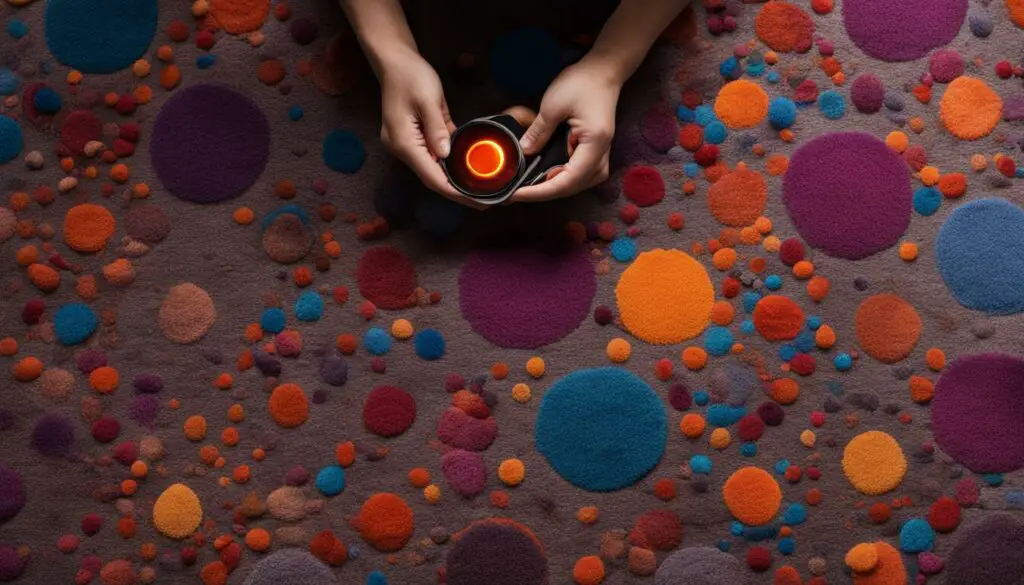
Using a UV Blacklight to Find Cat Pee Stains
One effective method for finding cat pee stains on your carpet is by using a UV blacklight. When urine dries, it becomes invisible to the naked eye, but it leaves behind certain chemicals that can be detected under UV light. A UV blacklight illuminates these chemicals, making the urine stains visible. By thoroughly scanning your carpet with a UV blacklight, you can pinpoint the location of the urine stains and treat them accordingly.
To use a UV blacklight effectively, follow these steps:
- Purchase a UV blacklight with a wavelength of around 395 nanometers.
- Wait until evening and turn off all the lights in the room to create a dark environment.
- Slowly sweep the UV blacklight over your carpet, paying close attention to areas where your cat frequents or where you smell the urine odor.
- Look for glowing yellow or neon green spots, puddles, or splatters, which indicate the presence of cat urine.
- Mark the edges of the urine stains with tape or chalk to easily identify them.
Using a UV blacklight can be a highly effective technique to detect cat urine stains on your carpet. It allows you to accurately locate the areas that need attention, ensuring a thorough cleaning and eliminating the odor. By following these steps, you can make the process of finding and treating cat pee stains much easier and more efficient.
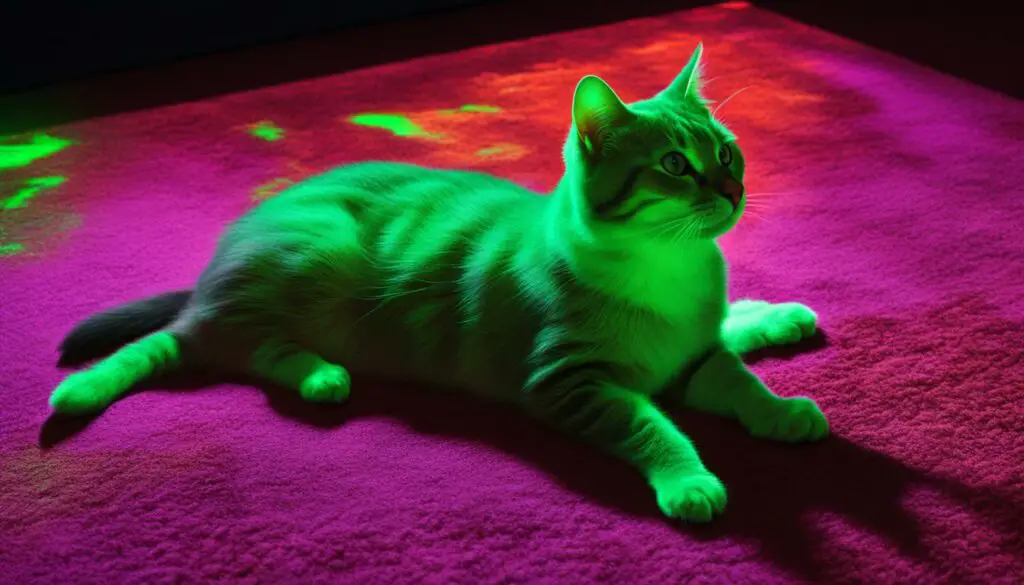
Advantages of Using a UV Blacklight
“A UV blacklight is a valuable tool for homeowners dealing with cat urine stains on their carpets. It allows for precise detection of hidden stains that would otherwise be challenging to find. By using a UV blacklight, you can effectively target and treat the specific areas affected, ensuring a thorough cleanup.”
– Home Cleaning Expert
Steps to Use a UV Blacklight to Find Cat Pee Stains
Using a UV blacklight is an effective method to locate cat pee stains on your carpet. Follow these steps to maximize your success:
- Purchase a UV blacklight with a wavelength of around 395 nanometers. This wavelength is ideal for detecting the chemicals left behind by cat urine.
- Wait until evening and turn off all the lights in the room to create a dark environment. This will make it easier to see the glow emitted by the urine stains under the UV light.
- Slowly sweep the UV blacklight over your carpet, paying close attention to areas where your cat frequently visits or where you smell the urine odor. These are the likely spots where urine stains may be present.
- Look for glowing yellow or neon green spots, puddles, or splatters. These indicate the presence of cat urine. Make sure to mark the edges of the urine stains with tape or chalk so that you can easily identify them later.
By following these steps, you can effectively use a UV blacklight to identify cat pee stains on your carpet. Once you have located the stains, you can proceed to the next step of removing the odor and ensuring a clean and fresh-smelling home.
Steps to Use a UV Blacklight to Find Cat Pee Stains
Using a UV blacklight is an effective method to locate cat pee stains on your carpet. Follow these steps to maximize your success:
- Purchase a UV blacklight with a wavelength of around 395 nanometers. This wavelength is ideal for detecting the chemicals left behind by cat urine.
- Wait until evening and turn off all the lights in the room to create a dark environment. This will make it easier to see the glow emitted by the urine stains under the UV light.
- Slowly sweep the UV blacklight over your carpet, paying close attention to areas where your cat frequently visits or where you smell the urine odor. These are the likely spots where urine stains may be present.
- Look for glowing yellow or neon green spots, puddles, or splatters. These indicate the presence of cat urine. Make sure to mark the edges of the urine stains with tape or chalk so that you can easily identify them later.
By following these steps, you can effectively use a UV blacklight to identify cat pee stains on your carpet. Once you have located the stains, you can proceed to the next step of removing the odor and ensuring a clean and fresh-smelling home.
| Step | Instructions |
|---|---|
| 1 | Purchase a UV blacklight with a wavelength of around 395 nanometers. This wavelength is ideal for detecting the chemicals left behind by cat urine. |
| 2 | Wait until evening and turn off all the lights in the room to create a dark environment. This will make it easier to see the glow emitted by the urine stains under the UV light. |
| 3 | Slowly sweep the UV blacklight over your carpet, paying close attention to areas where your cat frequently visits or where you smell the urine odor. These are the likely spots where urine stains may be present. |
| 4 | Look for glowing yellow or neon green spots, puddles, or splatters. These indicate the presence of cat urine. Make sure to mark the edges of the urine stains with tape or chalk so that you can easily identify them later. |
By following these steps, you can effectively use a UV blacklight to identify cat pee stains on your carpet. Once you have located the stains, you can proceed to the next step of removing the odor and ensuring a clean and fresh-smelling home.

Tips to Find Cat Urine on Carpet Without a UV Blacklight
If you don’t have access to a UV blacklight, there are still effective ways to find hidden cat urine stains on your carpet. Here are some tips to help you locate the problem areas:
Search Your Cat’s Favorite Spots
Cats often have preferred spots where they like to play or hide, and these areas are more likely to have urine stains. Take a close look at your cat’s favorite spots, such as corners, under furniture, or in secluded areas. Look for any discoloration, dampness, or a strong odor that may indicate the presence of cat urine.
Examine Corners and Edges
When cats urinate outside of the litter box, they often choose corners and edges of the room. Inspect the corners and edges of your carpet for any signs of staining or a urine smell. Don’t forget to check behind furniture or in tight spaces where your cat may have sprayed or marked its territory.
Focus on High-Traffic Areas
Another helpful tip is to pay attention to areas where your cat spends a lot of time, such as walkways or near its feeding area. Cats are creatures of habit, and they may prefer to urinate in these familiar locations. Thoroughly examine these high-traffic areas for any indications of cat urine stains.
By using these tips and closely inspecting your carpet, you can identify hidden cat urine stains without a UV blacklight. Once you locate the stains, you can take the necessary steps to eliminate the odor and keep your home fresh and clean.
| Common Areas to Check | Signs of Cat Urine |
|---|---|
| Favorite spots | – Discoloration – Dampness – Strong odor |
| Corners and edges | – Staining – Urine smell |
| High-traffic areas | – Concentrated urine smell – Discoloration |
Remember, it’s essential to address the underlying cause of your cat’s inappropriate urination behavior in order to prevent future accidents. If you’re unable to locate the urine stains or your cat continues to urinate outside of the litter box, consult with a veterinarian for further guidance and assistance.
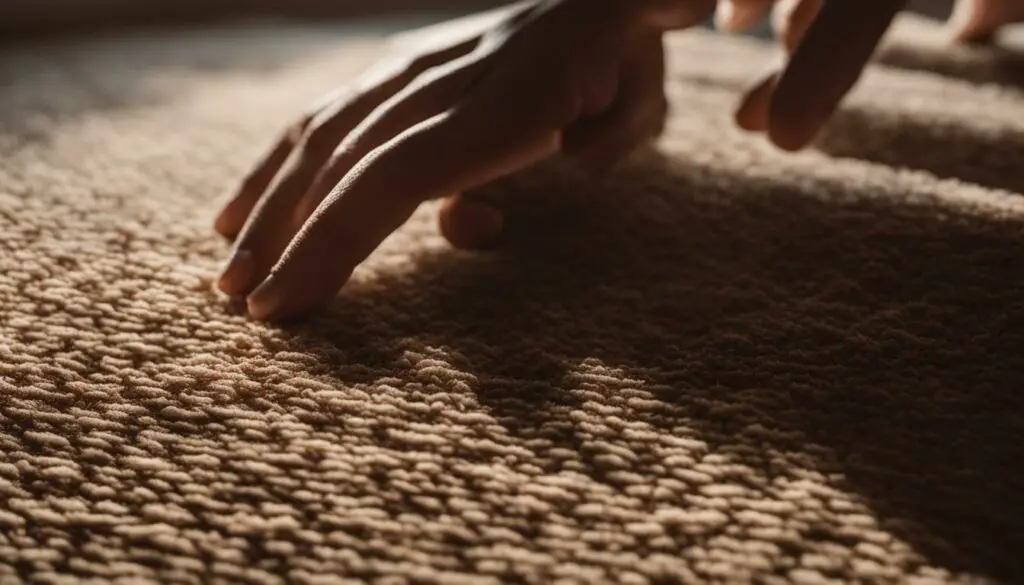
Even without a UV blacklight, you can still find cat urine stains by searching your cat’s favorite spots, examining corners and edges, and focusing on high-traffic areas.
Common Causes of Cat Pee Smell
When dealing with the unpleasant smell of cat urine in your home, it’s important to understand the common causes behind it. By identifying the root cause, you can address the issue and prevent future accidents. Here are some common reasons why your cat may be peeing outside of its litter box:
- Medical conditions: Cats with urinary tract infections or other health issues may urinate more frequently, resulting in a strong odor. If you notice any changes in your cat’s urination habits or suspect a medical condition, it’s essential to consult a veterinarian.
- Stress: Cats are sensitive creatures, and changes in their environment can cause stress, leading to inappropriate urination. Events such as the addition of a new pet or moving to a new house can trigger this behavior. Creating a calm and comfortable environment for your cat can help alleviate stress-related urination issues.
- Dirty litter box: Cats are known for their cleanliness, and a dirty or smelly litter box may discourage them from using it. If the litter box is not cleaned frequently or if it has a strong odor, your cat may seek alternative places to relieve itself. Regularly scooping the litter box and replacing the litter can help prevent accidents.
By addressing these common causes and implementing preventive measures, you can eliminate the cat pee smell in your home and create a more pleasant environment for both you and your furry friend.
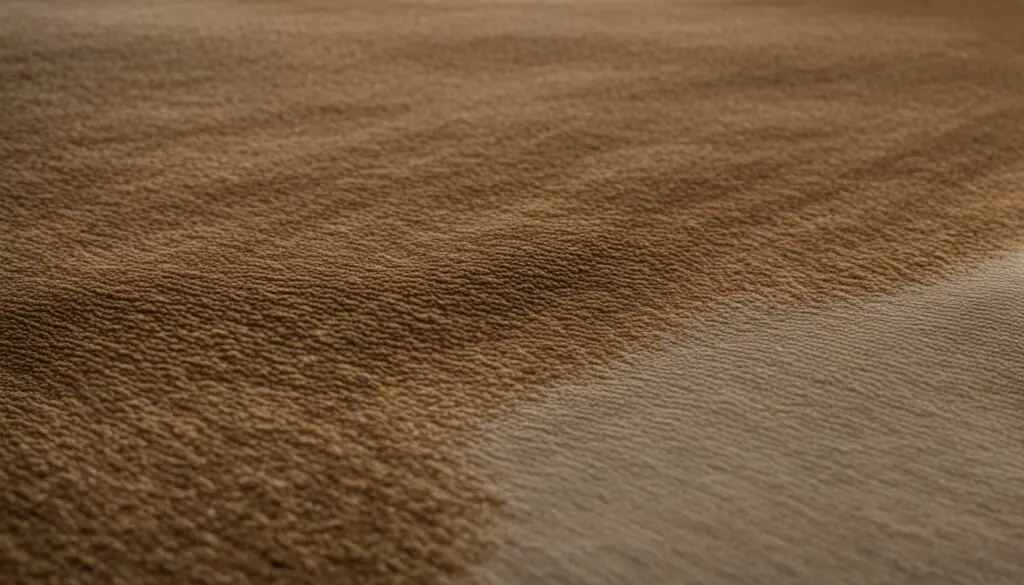
Dealing with Underlying Medical Conditions
Recognizing cat urine odor on your carpet is an important step in addressing the issue. If you suspect that there may be an underlying medical condition causing your cat to urinate outside of the litter box, it is crucial to consult a veterinarian. A vet can perform a thorough examination and run necessary tests to diagnose any medical issues. Treating the underlying condition will not only help eliminate the strong odor of cat urine but also improve your cat’s overall health.
Common medical conditions that can contribute to inappropriate urination in cats include urinary tract infections, bladder stones, and kidney disease. These conditions can cause increased frequency of urination and stronger-smelling urine. By addressing these medical issues, you can prevent further accidents and ensure your cat’s well-being.
Recognizing the Signs
It’s important to be aware of the signs that may indicate an underlying medical condition. Look out for frequent urination, blood in the urine, straining to urinate, or any changes in your cat’s behavior or litter box habits. If you notice any of these symptoms, it’s crucial to seek veterinary attention as soon as possible.
Inappropriate urination can be a sign of an underlying medical condition in cats. It’s important to consult a veterinarian to rule out any health issues.
Once a medical condition has been diagnosed, your veterinarian will recommend a treatment plan that may include medications, dietary changes, or other interventions. Following the veterinarian’s advice and providing the necessary care and treatment will help resolve the medical issue and prevent further accidents on your carpet.
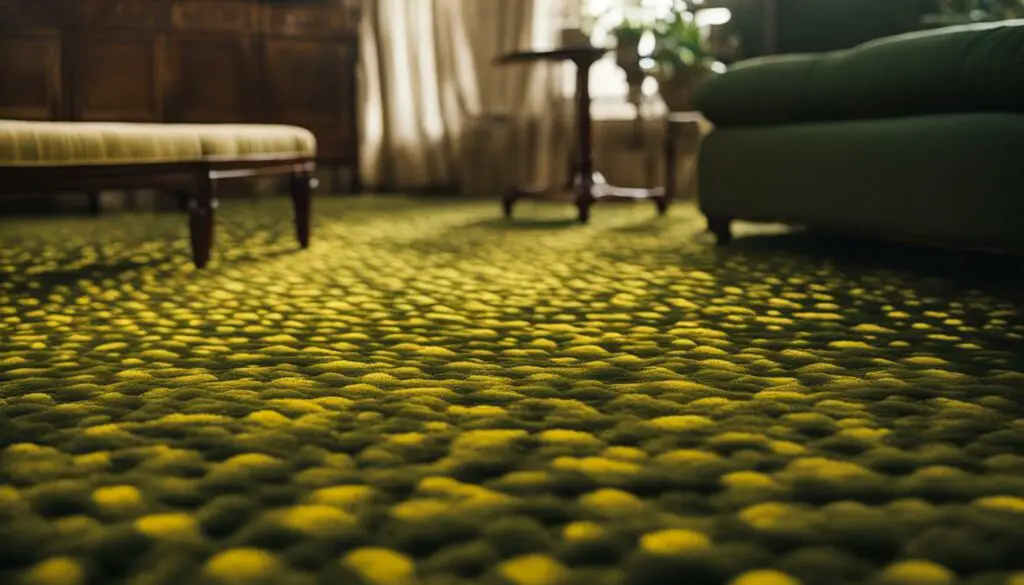
Proper Cleaning Techniques for Cat Pee Stains
Eliminating the smell of cat urine and effectively cleaning the stains is crucial to maintaining a fresh-smelling home. Follow these steps to properly clean cat pee stains from your carpet:
- Start by blotting up any wet urine with paper towels or a rag. Be sure to remove as much liquid as possible.
- Create a cleaning solution by mixing one part hydrogen peroxide with two parts water or vinegar. This solution will help break down the urine and eliminate the odor.
- Apply the cleaning solution to the affected area and let it sit for a few minutes. This will allow the solution to penetrate the stain and neutralize the odor.
- Gently blot the area again with a clean, damp cloth to remove the cleaning solution and any remaining urine residue. Avoid scrubbing the stain, as this can push it deeper into the carpet fibers.
- To further absorb any lingering odor, sprinkle baking soda over the treated area. Let it sit for at least 30 minutes and then vacuum it up. The baking soda will help eliminate any remaining smell.
By following these steps, you can effectively clean cat pee stains and eliminate the odor from your carpet. Remember to act quickly when dealing with cat urine stains, as prompt cleaning will yield better results.
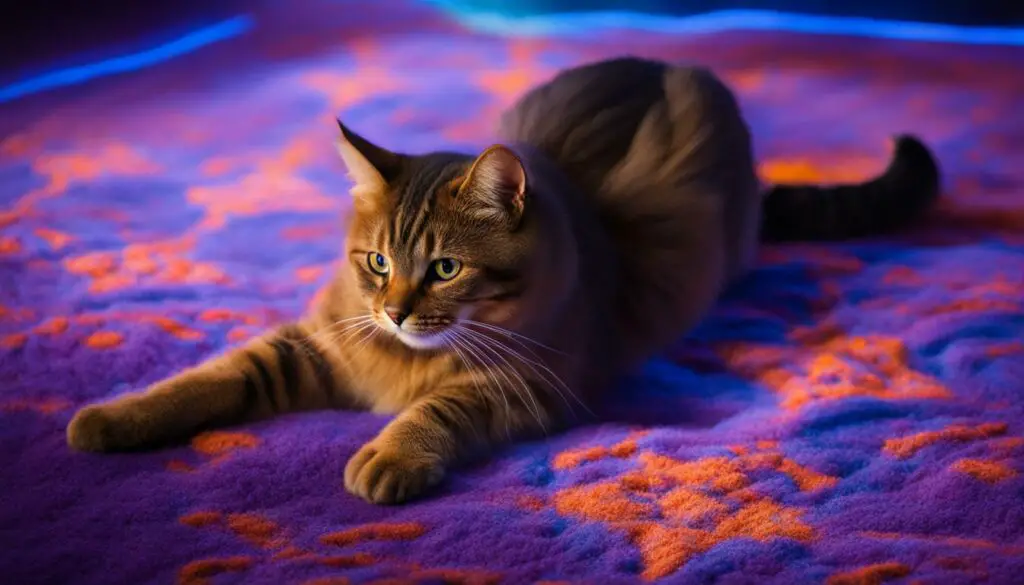
It’s important to note that certain types of carpets may require specialized cleaners or professional cleaning services. If you’re unsure about the proper cleaning method for your specific carpet type, it’s best to consult with a professional.
Proper cleaning techniques are essential for maintaining a clean and fresh-smelling home. By following these steps, you can effectively eliminate cat urine smell and keep your carpet looking and smelling its best.
Preventing Future Accidents
Preventing cat urine stains on your carpet is essential for maintaining a clean and odor-free home. By implementing these preventive measures, you can ensure that your cat uses the litter box consistently and avoids inappropriate urination:
- Keep the litter box clean and odor-free by scooping it daily and replacing the litter regularly. Cats prefer clean litter boxes and are more likely to use them.
- Provide multiple litter boxes in different locations throughout your home. This ensures that your cat always has easy access to a litter box, reducing the likelihood of accidents.
- Create a safe and comfortable environment for your cat. Minimize stress triggers and provide plenty of hiding places where your cat can feel secure and relaxed.
- Use deterrents to discourage your cat from urinating in unwanted areas. Citrus scents or aluminum foil placed in these areas can help deter your cat from marking their territory.
- Monitor your cat’s behavior closely. Look out for any changes or signs of distress that may indicate an underlying issue causing inappropriate urination.
By following these preventive measures, you can significantly reduce the chances of your cat urinating outside of the litter box and keep your carpet clean and fresh-smelling.
Key Takeaways:
- Keeping the litter box clean and providing multiple boxes in different locations encourages your cat to use them consistently.
- Creating a stress-free environment with plenty of hiding places helps minimize the likelihood of inappropriate urination.
- Using deterrents, such as citrus scents or aluminum foil, can discourage your cat from urinating in unwanted areas.
- Monitoring your cat’s behavior and seeking veterinary advice if necessary can help address any underlying medical conditions.
By following these tips, you can prevent future accidents and maintain a clean and pristine carpet in your home.
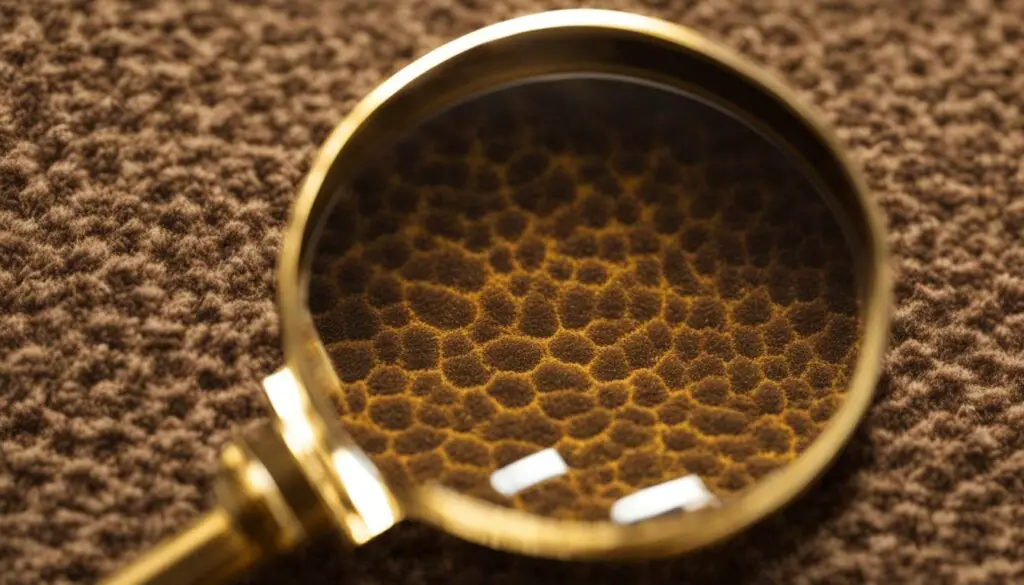
Conclusion
In conclusion, finding cat pee stains on your carpet can be a challenging task, but it is essential for maintaining a clean and odor-free home. By following the techniques and methods outlined in this guide, you can easily locate and identify cat urine stains on your carpet.
Using a UV blacklight or other alternative methods such as searching for favorite spots and examining hiding places can help you pinpoint the exact location of the urine stains. Once you have located the stains, it is crucial to clean and eliminate the odor effectively using the proper cleaning techniques outlined in this guide.
To prevent future accidents, it is important to take preventive measures such as keeping the litter box clean and odor-free, providing a comfortable environment for your cat, and monitoring their behavior. If you suspect an underlying medical condition, consulting a veterinarian is crucial for proper diagnosis and treatment.
By following these steps and taking proactive measures, you can successfully tackle the problem of cat pee on your carpet and ensure a fresh-smelling and cat-friendly home. Remember, with patience and persistence, you can maintain a clean and odor-free environment for both you and your beloved feline companion.
FAQ
How can I find cat pee stains on my carpet?
One effective method is to use a UV blacklight, which illuminates the chemicals left behind by dried urine, making the stains visible. You can also search for your cat’s favorite spots, examine corners and edges of the carpet, and areas where your cat spends a lot of time.
Why is it important to find cat pee stains on my carpet?
Cat urine stains not only emit an unpleasant odor but also cause damage to the carpet and create a breeding ground for bacteria. By locating and treating the stains promptly, you can prevent further damage and maintain a clean and odor-free home.
How do I use a UV blacklight to find cat pee stains?
Purchase a UV blacklight with a wavelength of around 395 nanometers. Turn off all the lights in the room to create a dark environment. Sweep the UV blacklight over your carpet, paying attention to areas where your cat frequents or where you smell the urine odor. Look for glowing yellow or neon green spots, puddles, or splatters, and mark the edges of the stains for easy identification.
How can I find cat pee stains without a UV blacklight?
You can search for your cat’s favorite playing or hiding places, as they often choose specific spots to relieve themselves. Additionally, examine corners and edges of the carpet and any areas where your cat spends a lot of time.
What are the common causes of cat pee smell?
Some common causes include medical conditions like urinary tract infections, stress, and a dirty litter box.
How should I deal with underlying medical conditions?
If you suspect a medical condition, consult a veterinarian for a thorough examination and necessary tests. The vet may prescribe treatment, medication, or changes in diet to address the issue.
What are the proper cleaning techniques for cat pee stains?
Blot up wet urine, prepare a cleaning solution using hydrogen peroxide or vinegar, apply it to the affected area, blot again with a clean cloth, sprinkle baking soda, let it sit, and then vacuum thoroughly.
How can I prevent future accidents?
Keep the litter box clean and odor-free, provide multiple litter boxes in different locations, create a safe and comfortable environment, use deterrents, and monitor your cat’s behavior.
What steps should I take to find cat pee on my carpet?
Use a UV blacklight or other methods to locate the stains, address any underlying medical conditions, clean the stains effectively, and implement preventive measures.

